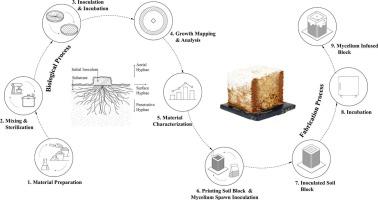Nutrient-enriched soil inks for 3D-printed mycelium-based living building materials
IF 7.9
2区 材料科学
Q1 MATERIALS SCIENCE, MULTIDISCIPLINARY
引用次数: 0
Abstract
This study develops nutrient-enriched soil composite inks for 3D printing, followed by mycelium colonization to create large-scale, mycelium-based living building materials (LBMs). The research focuses on enhancing the properties of 3D-printed soil composites by utilizing mycelial hyphal networks to create sustainable construction solutions. A primary challenge lies in calibrating the nutrient levels to support mycelium growth while ensuring the admixture remains printable and suitable for sustaining mycelial development. The study assesses the effects of malt extract agar (MEA) as an additive in soil composites, examining its impact on mycelium growth, water-related properties, and self-regenerative capabilities.
Findings indicate that soil composites containing 10 wt% MEA supports balanced mycelium growth across aerial, surface, and penetrative levels. Mycelial networks within the soil composite ink improve water-related properties, enhance structural integrity, and reduce shrinkage compared to composites without mycelium. Furthermore, the mycelium-soil composite demonstrates self-regenerative capabilities by bridging gaps created within the samples. This research contributes to the advancement of LBMs for sustainable earth-based construction, utilizing the inert properties of mycelium to enhance soil characteristics for 3D printing.

营养丰富的土壤油墨用于3d打印菌丝体为基础的生活建筑材料
本研究开发了用于3D打印的营养丰富的土壤复合油墨,随后进行菌丝体定植,以创建大规模的、基于菌丝体的活建筑材料(lbm)。该研究的重点是通过利用菌丝菌丝网络来创建可持续的建筑解决方案,从而增强3d打印土壤复合材料的性能。一个主要的挑战在于校准营养水平以支持菌丝生长,同时确保混合物仍然可打印并适合维持菌丝发育。该研究评估了麦芽提取物琼脂(MEA)作为土壤复合材料添加剂的效果,考察了其对菌丝体生长、水相关特性和自我再生能力的影响。研究结果表明,含有10 wt% MEA的土壤复合材料支持菌丝体在空中、表面和渗透水平上的平衡生长。与没有菌丝体的复合材料相比,土壤复合油墨中的菌丝体网络改善了与水有关的性能,增强了结构完整性,并减少了收缩。此外,菌丝-土壤复合材料通过弥合样品内部产生的间隙,展示了自我再生能力。本研究利用菌丝体的惰性特性来增强3D打印的土壤特性,促进了lbm在可持续地基建筑中的发展。
本文章由计算机程序翻译,如有差异,请以英文原文为准。
求助全文
约1分钟内获得全文
求助全文
来源期刊

Materials & Design
Engineering-Mechanical Engineering
CiteScore
14.30
自引率
7.10%
发文量
1028
审稿时长
85 days
期刊介绍:
Materials and Design is a multi-disciplinary journal that publishes original research reports, review articles, and express communications. The journal focuses on studying the structure and properties of inorganic and organic materials, advancements in synthesis, processing, characterization, and testing, the design of materials and engineering systems, and their applications in technology. It aims to bring together various aspects of materials science, engineering, physics, and chemistry.
The journal explores themes ranging from materials to design and aims to reveal the connections between natural and artificial materials, as well as experiment and modeling. Manuscripts submitted to Materials and Design should contain elements of discovery and surprise, as they often contribute new insights into the architecture and function of matter.
 求助内容:
求助内容: 应助结果提醒方式:
应助结果提醒方式:


